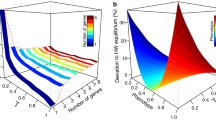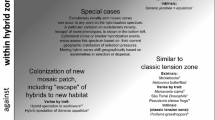Abstract
Compared to the vast theoretical literature on the dynamics of single species invasions, relatively few models have dealt with the emergence of invasive hybrids. Here, we review the variety of modeling approaches that have been used to study the dynamics of hybridization, outlining the underlying assumptions and highlighting their advantages and disadvantages. We summarize the predicted outcomes for the persistence for the native species and the resulting genetic composition of the native–exotic–hybrid complex under a variety of model scenarios. We highlight promising future directions for theoretical investigation and its integration with experimental studies.
Similar content being viewed by others
References
Ayres DR, Zaremba K, Strong DR (2004) Extinction of a common native species by hybridization with an invasive congener. Weed Technol 18:288–1291
Barton NH, Hewitt GM (1985) Analysis of hybrid zones. Ann Rev Ecol Syst 16:113–148
Barton NH, Shpak M (2000) The effect of epistasis on the structure of hybrid zones. Gen Res 75:179–198
Bossenbroek JM, Johnson LE, Peters B, Lodge DM (2007) Forecasting the expansion of zebra mussels in the United States. Conserv Biol 21:800–810
Brusati ED, Grosholz ED (2006) Native and introduced ecosystem engineers produce contrasting effects on estuarine infaunal communities. Biol Invasions 8:683–695
Campbell DR, Waser NM, Pederson GT (2002) Predicting patterns of mating and potential hybridization from pollinator behavior. Am Nat 159:438–450
Culley TM, Hardiman NA The role of intraspecific hybridization in the evolution of invasiveness: a case study of the ornamental pear tree Pyrus calleryana. Biol Invasions. doi:10.1007/s10530-008-9386-z
Durrett R, Buttel L, Harrison R (2000) Spatial models for hybrid zones. Heredity 84:9–19
Ellstrand NC, Schierenbeck KA (2000) Hybridization as a stimulus for the evolution of invasiveness in plants? Proc Natl Acad Sci USA 97:7043–7050
Epifanio J, Philipp D (2001) Simulating the extinction of parental lineages from introgressive hybridization: the effects of fitness, initial proportions of parental taxa, and mate choice. Rev Fish Biol Fish 10:339–354
Ferdy J-B, Austerlitz F (2002) Extinction and introgression in a community of partially cross-fertile plant species. Am Nat 160:74–86
Griebeler EM, Muller JC, Seitz A (2006) Spatial genetic patterns generated by two admixing genetic lineages: a simulation study. Conserv Gen 7:753–756
Hall RJ, Hastings A, Ayres DR (2006) Explaining the explosion: modelling hybrid invasions. Proc R Soc B 1592:1385–1389
Hastings A (1997) Population Biology: concepts and models. Springer, New York, USA
Hastings A, Hall RJ, Taylor CM (2006) A simple approach to optimal control of invasive species. Theor Popul Biol 70:431–435
Hegde SG, Nason JD, Clegg JM, Ellstrand NC (2006) The evolution of California’s wild radish has resulted in the extinction of its progenitors. Evolution 60:1187–1197
Hooftman DAP, De Jong MJ, Oostermeijer JGB, Den Nijs JCM (2007) Modelling the long-term consequences of crop-wild relative hybridization: a case study using four generations of hybrids. J Ap Ecol 44:1035–1045
Hu X-S (2005) Tension versus ecological zones in a two-locus system. Theor Popul Biol 68:119–131
Huxel GR (1999) Rapid displacement of native species by invasive species: effects of hybridization. Biol Conserv 89:143–152
Jerde CL, Lewis MA (2007) Waiting for invasions: a framework for the arrival of nonindigenous species. Am Nat 170:1–9
Jiggins JG, Mallet (2000) Bimodal hybrid zones and speciation. Trends Ecol Evol 15:250–255
Keeler MS, Chew FS, Goodale BC, Reed JM (2006) Modelling the impacts of two exotic invasive species on a native butterfly: top-down vs. bottom-up effects. J Anim Ecol 75:777–788
Pimentel D, Zuniga R, Morrison D (2005) Update on the environmental and economic costs associated with alien-invasive species in the United States. Ecol Econ 52:273–288
Perry WL, Feder JL, Dwyer G, Lodge DM (2001) Hybrid zone dynamics and species replacement between Orconectes crayfishes in a northern Wisconsin lake. Evolution 55:1153–1166
Rieseberg LH, Raymond O, Rosenthal DM, Lai Z, Livingstone K, Nakazato T, Durphy JL, Schwarzbach AE, Donovan LA, Lexer C (2003) Major ecological transitions in wild sunflowers facilitated by hybridization. Science 29:1211–1216
Rieseberg LH, Kim S-C, Randell RA, Whitney KD, Gross BL, Lexer C, Clay K (2007) Hybridization and the colonization of novel habitats by annual sunflowers. Genetica 129:2–149
Rhymer JM, Simberloff D (1996) Extinction by hybridization and introgression. Ann Rev Ecol Syst 27:83–109
Slobodkin LB (1961) Growth and regulation of animal populations. Holt, Rinehart and Winston, New York, USA
Sloop CM (2005) The reproductive ecology and recruitment dynamics underlying the accelerating invasive spread of hybrid cordgrasses (S. alterniflora × S. foliosa) in San Francisco Bay Tidal Flats, Ph.D. Dissertation, UC Davis, CA
Taylor CM, Hastings A (2004) Finding optimal control strategies for invasive species: a density-structured model for Spartina alterniflora. J Ecol 41:1049–1057
Thompson CJ, Thompson BJP, Ades PK, Cousens R, Garnier-Gere P, Landman K, Newbigin E, Burgman MA (2003) Model-based analysis of the likelihood of gene introgression from genetically modified crops into wild relatives. Ecol Model 162:199–209
Valbuena-Carabaña M, Gonzalez-Martinez SC, Hardy OJ, Gil L (2007) Fine-scale genetic structure in mixed oak stands with different levels of hybridization. Mol Ecol 16:1207–1219
Wilcove DS, Rothstein D, Bubow J, Phillips A, Losos E (1998) Quantifying threats to imperiled species in the United States. Bioscience 48:607–615
Williamson M (1996) Biological invasions. Chapman and Hall, London
Wolf DE, Takebayashi N, Rieseberg LH (2001) Predicting the risk of extinction through hybridization. Conserv Biol 15:1039–1053
Author information
Authors and Affiliations
Corresponding author
Rights and permissions
About this article
Cite this article
Hall, R.J., Ayres, D.R. What can mathematical modeling tell us about hybrid invasions?. Biol Invasions 11, 1217–1224 (2009). https://doi.org/10.1007/s10530-008-9387-y
Received:
Revised:
Accepted:
Published:
Issue Date:
DOI: https://doi.org/10.1007/s10530-008-9387-y




